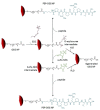The Peptide Functionalized Inorganic Nanoparticles for Cancer-Related Bioanalytical and Biomedical Applications
- PMID: 34072160
- PMCID: PMC8198790
- DOI: 10.3390/molecules26113228
The Peptide Functionalized Inorganic Nanoparticles for Cancer-Related Bioanalytical and Biomedical Applications
Abstract
In order to improve their bioapplications, inorganic nanoparticles (NPs) are usually functionalized with specific biomolecules. Peptides with short amino acid sequences have attracted great attention in the NP functionalization since they are easy to be synthesized on a large scale by the automatic synthesizer and can integrate various functionalities including specific biorecognition and therapeutic function into one sequence. Conjugation of peptides with NPs can generate novel theranostic/drug delivery nanosystems with active tumor targeting ability and efficient nanosensing platforms for sensitive detection of various analytes, such as heavy metallic ions and biomarkers. Massive studies demonstrate that applications of the peptide-NP bioconjugates can help to achieve the precise diagnosis and therapy of diseases. In particular, the peptide-NP bioconjugates show tremendous potential for development of effective anti-tumor nanomedicines. This review provides an overview of the effects of properties of peptide functionalized NPs on precise diagnostics and therapy of cancers through summarizing the recent publications on the applications of peptide-NP bioconjugates for biomarkers (antigens and enzymes) and carcinogens (e.g., heavy metallic ions) detection, drug delivery, and imaging-guided therapy. The current challenges and future prospects of the subject are also discussed.
Keywords: biosensing nanoplatform; cancer; inorganic nanoparticle; nanomedicine; peptide ligand.
Conflict of interest statement
The authors declare no conflict of interest.
Figures











Similar articles
-
Functional DNA Molecules Enable Selective and Stimuli-Responsive Nanoparticles for Biomedical Applications.Acc Chem Res. 2019 Sep 17;52(9):2415-2426. doi: 10.1021/acs.accounts.9b00167. Epub 2019 Aug 14. Acc Chem Res. 2019. PMID: 31411853 Free PMC article. Review.
-
Peptide-Functionalized Nanomedicine: Advancements in Drug Delivery, Diagnostics, and Biomedical Applications.Molecules. 2025 Mar 31;30(7):1572. doi: 10.3390/molecules30071572. Molecules. 2025. PMID: 40286158 Free PMC article. Review.
-
Peptide-functionalized gold nanoparticles: versatile biomaterials for diagnostic and therapeutic applications.Biomater Sci. 2017 May 2;5(5):872-886. doi: 10.1039/c7bm00006e. Biomater Sci. 2017. PMID: 28304023 Review.
-
Targeting tumor microenvironment with RGD-functionalized nanoparticles for precision cancer therapy.Cancer Lett. 2025 Apr 1;614:217536. doi: 10.1016/j.canlet.2025.217536. Epub 2025 Feb 7. Cancer Lett. 2025. PMID: 39924081 Review.
-
Targeted nanomedicine for cancer therapeutics: Towards precision medicine overcoming drug resistance.Drug Resist Updat. 2017 Mar;31:15-30. doi: 10.1016/j.drup.2017.05.002. Epub 2017 May 21. Drug Resist Updat. 2017. PMID: 28867241 Review.
Cited by
-
Research Progress on Nanoparticles-Based CRISPR/Cas9 System for Targeted Therapy of Tumors.Biomolecules. 2022 Sep 5;12(9):1239. doi: 10.3390/biom12091239. Biomolecules. 2022. PMID: 36139078 Free PMC article. Review.
-
In vitro assessment of the effect of magnetic fields on efficacy of biosynthesized selenium nanoparticles by Alborzia kermanshahica.BMC Biotechnol. 2024 May 9;24(1):27. doi: 10.1186/s12896-024-00855-4. BMC Biotechnol. 2024. PMID: 38725019 Free PMC article.
-
Nanobiotechnology and Immunotherapy: Two Powerful and Cooperative Allies against Cancer.Cancers (Basel). 2021 Jul 27;13(15):3765. doi: 10.3390/cancers13153765. Cancers (Basel). 2021. PMID: 34359665 Free PMC article. Review.
-
Inhibiting Metastasis and Improving Chemosensitivity via Chitosan-Coated Selenium Nanoparticles for Brain Cancer Therapy.Nanomaterials (Basel). 2022 Jul 29;12(15):2606. doi: 10.3390/nano12152606. Nanomaterials (Basel). 2022. PMID: 35957037 Free PMC article.
-
Metal-based nanomaterials and nanocomposites as promising frontier in cancer chemotherapy.MedComm (2020). 2023 Apr 4;4(2):e253. doi: 10.1002/mco2.253. eCollection 2023 Apr. MedComm (2020). 2023. PMID: 37025253 Free PMC article. Review.
References
-
- Wild C., Weiderpass E., Stewart B. In: World Cancer Report: Cancer Research for Cancer Prevention. Wild C., Weiderpass E., Stewart B., editors. International Agency for Research on Cancer; Lyon, France: 2020.
-
- Wang Z.X., Ma L.N. Gold nanoparticle probes. Coordin. Chem. Rev. 2009;253:1607–1618. doi: 10.1016/j.ccr.2009.01.005. - DOI
Publication types
MeSH terms
Substances
Grants and funding
LinkOut - more resources
Full Text Sources
Other Literature Sources
Medical
Miscellaneous

